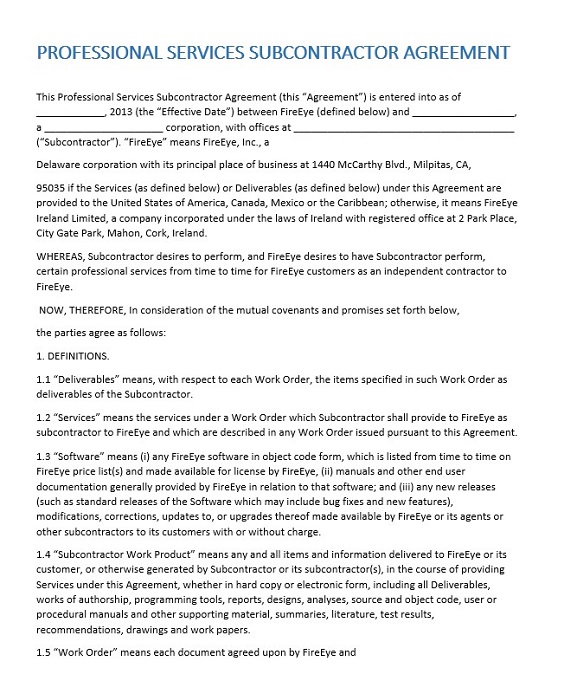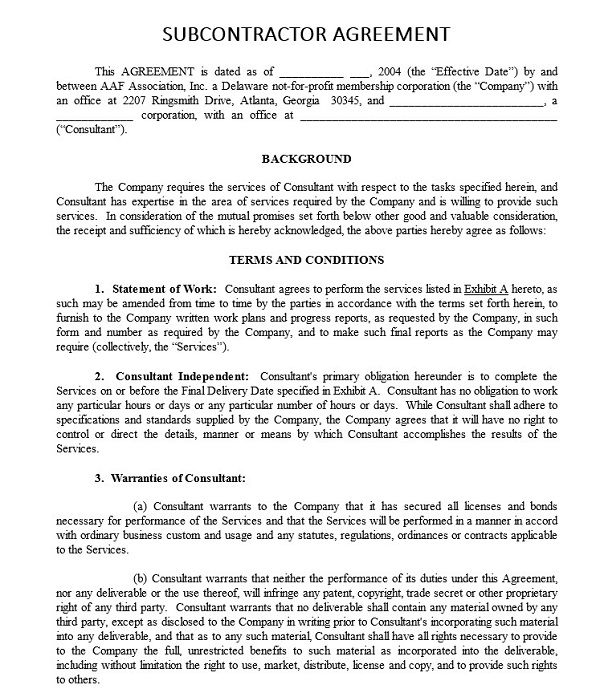The simple subcontractor agreement template is the necessary document that defines the terms of the agreement related to your business between a subcontractor and a contractor. You should know that this document needs specific information linked to the terms of the agreement in brief, clear language and can be applied legally as well. You will need a professional firm to make this document with the legally binding consequence if one of both parties breaks the agreement. Let’s learn more about it!
Understanding the Subcontractor Agreement
This document has some parts and inclusions. You can benefit from using the subcontractor agreement template that contains all the parts you need to include when making the contract. If you do not hire a law professional to complete all detailed agreements, then using formal templates made before can be your best option.
All you need is to include all details related to the contract in the form, including the contract, which is still legally binding.
Why Use a Subcontractor Agreement Template?
Here are some big reasons to use a subcontractor agreement template:
- Save money:
Hiring a lawyer to make a new agreement can cost a lot. A template is like a ready-made agreement. Just fill in your details, and you’re good to go. It means you can save money and still get a solid agreement.
- Save Time:
Templates are like a roadmap. They have all the sections you need. You have to add the right information. No need to think about what to include. It means you can get your agreement done faster.
- Stay Safe Legally:
Even if it’s a template, it’s still a legal contract templates document. Once both sides sign it, it’s official. It means both the main contractor and the subcontractor have rules to follow. If someone doesn’t do what they promised, the agreement can help solve any issues.
Key Components to Include in the Agreement
When two parties, like a contractor-subcontractor relationship, decide to work together, they need a special paper called a subcontractor agreement.
This paper is like a set of rules they both agree to follow. Although templates can give a starting point, adding specific details is important. Let’s take a closer look at these essential parts:
Names of the Parties Involved
It is like writing down the names of players in a game. It’s important to list:
- The full name of the contractor’s company.
- The full name of the subcontractor’s company.
- Any contact details like addresses, phone numbers, and emails.
What the Work is About (Scope of Work)
This section is like a list of tasks in a game. It tells:
- What jobs does the subcontractor need to do?
- How the final work should look.
- Any special things the subcontractor needs to use or avoid.
How and When to Pay (Payment Details)
It is about the rewards in the game! It tells:
- How much money the subcontractor will get?
- When they’ll get this money (like after finishing a task or at the end).
- How they’ll get paid, such as by check, bank transfer, or cash.
How Long the Game Lasts (Project Duration Terms of the Contract)
This part sets the game’s timer. It includes:
- The start date: when the subcontractor begins their work.
- The end date: when the work should be finished.
- Any special dates in between that are important.
How to End the Game Early (Termination Clauses)
Sometimes, one side might want to stop before the game ends. This section says:
- The reasons someone can end the contract early.
- How much notice do they need to give?
- If there’s any money involved in ending early.
Solving Problems (Dispute Resolution Procedures)
If there’s a disagreement or problem, this part helps find a solution. It tells:
- How to talk about problems and try to solve them.
- Where can they go for help, like a mediator or court, if they can’t agree?
- Who pays for any costs if there’s a disagreement?
Who Can Benefit from a Subcontractor Agreement Template?
A subcontractor agreement template is like a blueprint or a guide for a special contract. But who needs this blueprint? Let’s find out:
Contractors
Contractors are like team captains. They get a big job and might need help to finish it. They can use this template when they want to hire a subcontractor to do a part of that big job.
Subcontractors
Subcontractors are like players hired onto the team. This template helps them understand what the contractor expects and what they’ll get in return.
Business Owners
Sometimes, business owners have many projects. They might hire different teams (contractors) for each project. Having a template makes sure every team follows the same rules.
Legal Professionals
Lawyers and legal assistants often help make contracts. A template can save them time and ensure they remember all important details.
Small Business Owners
If a business owner is starting, they might not have much money to hire a lawyer. A template gives them a good starting point to make their contract.
Schools and Training Centers
Places that teach about business or construction subcontracts might use the template as a teaching tool. It helps students learn about real-world contracts.
Freelancers
People who do jobs on their own, like designers or writers, may work as subcontractors. A template helps them set clear rules with the people hiring them.
Trade Associations
Groups that support certain jobs, like electricians or painters, might offer templates to their members. It helps all members follow the same good practices.
Many people and groups can use a subcontractor agreement template. It’s like a rulebook or a guide that helps everyone play the game fairly and know what to expect.
Do I Need a Lawyer to Use a Subcontractor Agreement Template?
A subcontractor agreement template is like a pre-made recipe for a dish. But instead of food, it’s for setting rules between contractors and subcontractors. Let’s dive deeper:
Understanding the Basics
A template is designed to be user-friendly. It lays out the general contract terms most agreements might need, making it easy for anyone to fill in specific details. It means that, technically, you can use it without a lawyer.
Why Consider a Lawyer?
Think of a lawyer as a seasoned chef who knows the recipe inside out:
- Expertise: Just as a chef knows the right mix of ingredients, a lawyer understands legal language and can ensure the contract protects your interests.
- Customization: Every job is unique. A lawyer can tailor the agreement to your needs, ensuring all important details are noticed.
- Avoiding Pitfalls: A chef can predict if a dish might turn out wrong. Similarly, a lawyer can spot potential problems in an agreement and fix them before they become issues.
When Might You Not Need a Lawyer?
- Simple Tasks: A basic template might be enough if the job is straightforward and both parties trust each other.
- Budget Concerns: Hiring a lawyer can be expensive. If the budget is tight, a template can be a starting point. However, always be cautious and understand every part of the agreement.
The Middle Ground
If you’re unsure about hiring a lawyer but want some assurance:
- Legal Review: Instead of drafting subcontract agreements, use the template to create your contract and have a lawyer contract review checklist it. It can be less costly than full legal services.
- Online Legal Platforms: Some online platforms offer legal advice at a reduced cost or provide more specialized templates.
Peace of Mind
While a template can guide you, a lawyer provides peace of mind. They ensure that the agreement stands up in court and truly reflects the understanding between both parties.
Sample Subcontractor Agreement: A Basic Template Guide
This agreement is made this [Date] by and between [Contractor’s Full Name/Company Name], from now on referred to as the “Contractor,” and [Subcontractor’s Full Name/Company Name], from now on referred to as the “Subcontractor.”
- Scope of Work:
Subcontractor agrees to provide the following services:
[Detailed description of the work to be performed by the subcontractor]- Payment Terms:
The contractor agrees to pay the subcontractor a total fee of [Amount in $], payable as follows:
[Payment details, e.g., 50% upfront, 50% upon completion]- Duration of Contract:
This agreement will begin on [Start Date] and terminate on [End Date].
- Termination Conditions:
- Independent contractor:
The subcontractor is an Independent contractor agreement and is not considered an employee of the contractor.
- Confidentiality:
The confidentiality in subcontracting agrees not to share any confidential information learned during this project.
- Non-Compete:
The subcontractor agrees not to work with a direct competitor of the contractor for a duration of [e.g., 12 months] after the termination of this agreement.
- Work for Hire:
All work performed under this agreement shall be considered “work made for hire” and the contractor’s property.
- Insurance:
- Dispute Resolution:
Any disputes arising from this agreement will be resolved through [e.g., mediation, arbitration, or a court of law].
- Governing Law:
This agreement shall be governed by the laws of [State/Country].
- Entire Agreement:
This document contains the entire agreement between Contractor and Subcontractor and supersedes any previous understandings, written or oral, relating to the subject of this agreement.
Signatures:
Contractor (Signature & Date) Subcontractor (Signature & Date)
What Happens When Rules in the Subcontractor Agreement Are Broken?
In a subcontractor agreement, there are rules or terms that both parties agree to follow. But what happens when someone doesn’t stick to these rules? Let’s explore:
Breach of Contract
When one side doesn’t follow the rules in the agreement, it’s often called a “breach of contract.” It means that one party has yet to do what they promised in the written agreement.
Consequences Laid Out in the Agreement
Most agreements have a section discussing what will happen if the rules are broken. It might include:
- Paying a fine or penalty.
- Fixing the problem within a certain time.
- Paying for any damage or loss caused by not following the rules.
Mediation or Arbitration
Sometimes, both sides agree to talk about the problem with a neutral mediator. This person helps them find a solution without going to court. If they choose arbitration, an arbitrator (like a judge) will hear both sides and decide how to solve the problem.
Going to Court
If talking doesn’t help, one side might decide to take the matter to court. Here, a judge will listen to both parties and decide based on the law and the agreement.
Termination of Agreement
In some cases, the agreement might end if the rules are broken. For example, if a subcontractor doesn’t finish a job on time, the contractor might have the right to end the agreement and hire someone else.
Damage to Reputation
Breaking the rules in a business agreement can also harm a company’s or person’s reputation. Future partners or customers might think twice before working with someone who doesn’t stick to their promises.
Financial Implications
Not following the agreement can also lead to extra costs. For example, if work is delayed, it might cost more money to finish it later. Or, if one side has to go to court, they might have to pay legal compliance in subcontracting fees.
Opportunity to Make Amends
Sometimes, if a mistake is genuine, the party in breach might get a chance to fix it. It could mean redoing a task, paying late, or taking other steps to set things right.
Free Simple Subcontractor Agreement Template (Word & PDF)
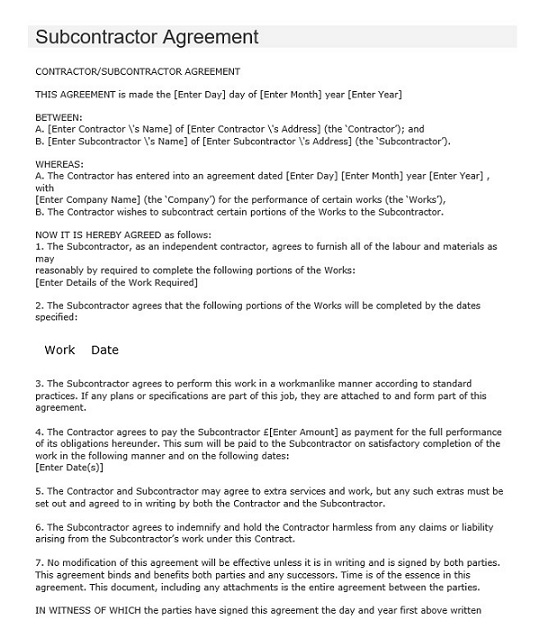
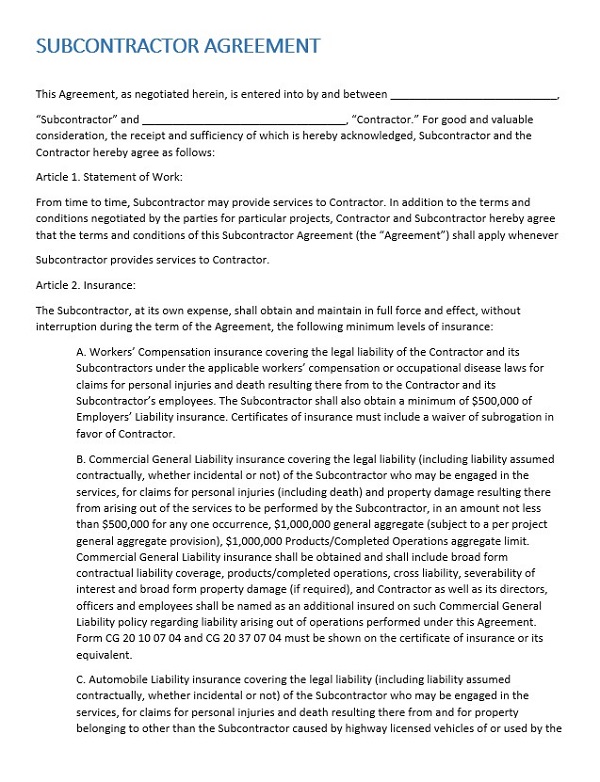
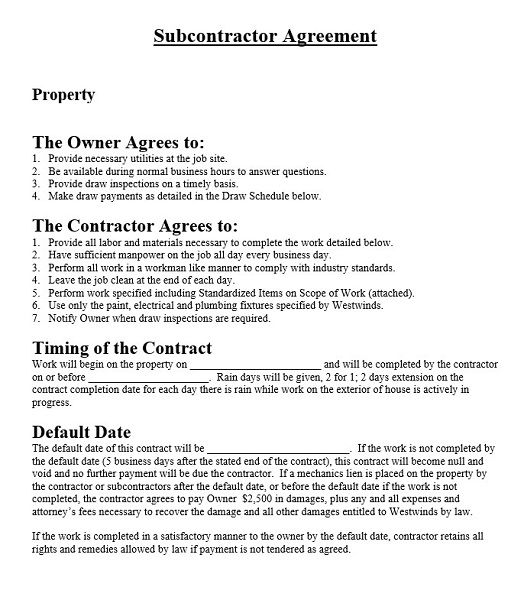
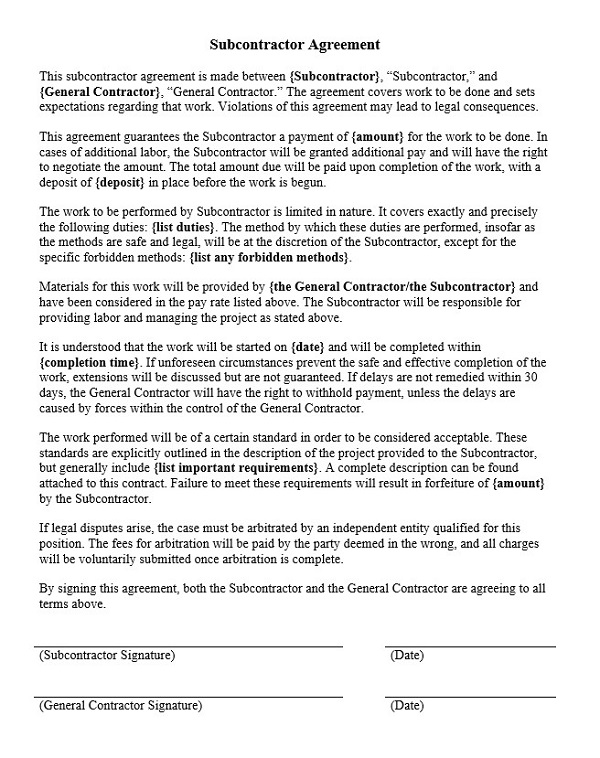
Free subcontractor agreement template
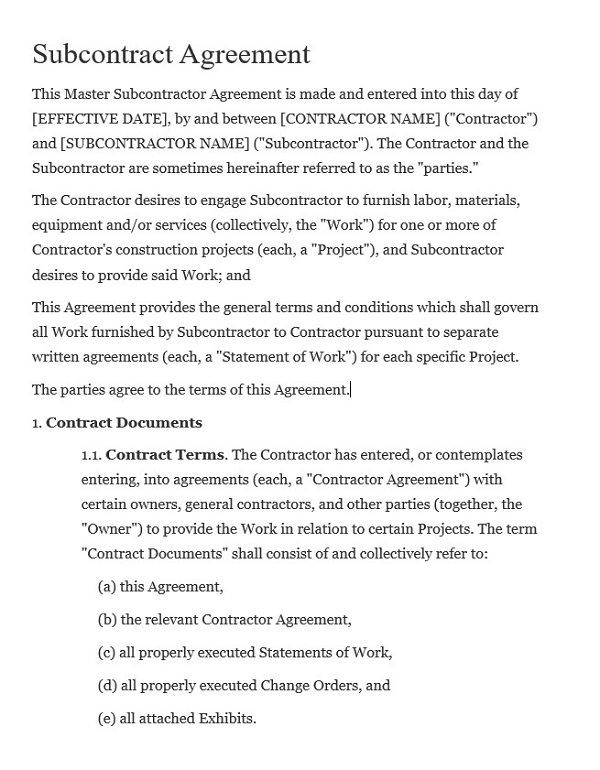
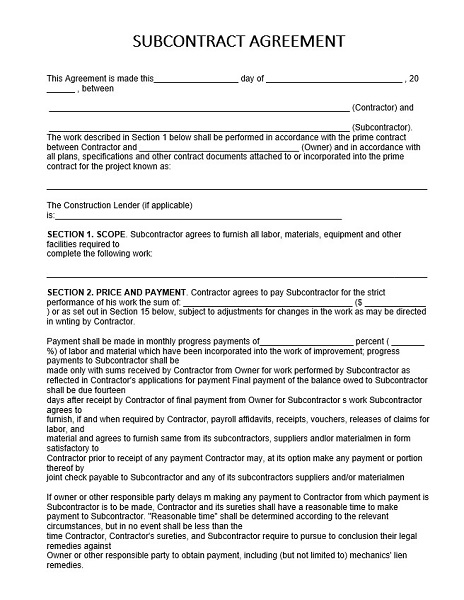
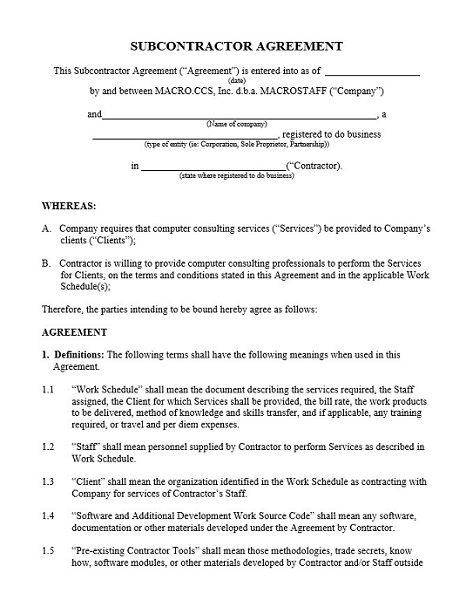
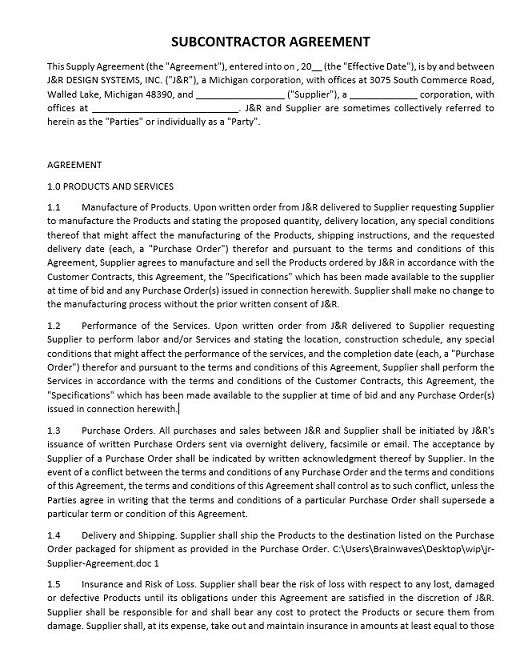
Tips for Writing an Effective Subcontractor Agreement Template
An effective agreement ensures smooth operations and minimizes misunderstandings. Here are some tips to help you draft an impeccable subcontractor agreement template:
- Start with Clear Definitions
- Like “Contractor,” “Subcontractor,” “Services,” “Project,” etc., to avoid any confusion later on.
- Specify the Scope of Work Template
- Detail the specific tasks, deliverables, and expectations for the subcontractor.
- Consider using bullet points or lists for clarity.
- Be Transparent About Payment
- State payment amounts, schedules, and methods.
- Define terms for additional expenses or overages.
- Set Timeframes
- Specify start and end dates.
- Include milestones or checkpoints, especially for longer projects.
- Highlight Responsibilities
- Clearly outline the responsibilities and duties template of both the contractor and subcontractor.
- It can include providing tools, materials, or specific information.
- Address Confidentiality
- If the subcontractor will have access to sensitive information, include a confidentiality or non-disclosure clause.
- Plan for Changes
- Define a process for making changes to the agreement or scope of work. It can help manage expectations and prevent disputes.
- Include Termination Clauses
- Specify under what conditions either party can end the contract.
- Address issues like breach of contract missed deadlines, or other discrepancies.
- Address Dispute Resolution
- Outline steps to resolve disagreements, whether it’s through mediation, arbitration, or legal action.
- Consider Intellectual Property
- If the subcontractor is creating designs, content, or other intellectual property rights in subcontracting, clarify who owns it upon completion.
- Detail Insurance and Liabilities
- State who is responsible for insurance coverage and outline liability in case of accidents or damages.
- Avoid Jargon
- Use simple, clear language whenever possible. Remember, the goal is understanding, not complexity.
- Review Local Laws
- Ensure your agreement is compliant with local laws and regulations. What’s standard subcontractor contract in one jurisdiction might not be in another.
- Leave Space for Flexibility
- While clarity is essential, avoid being too rigid. Sometimes, It can affect the project, so consider including indemnification clauses that allow for flexibility.
- Always Get Legal Review
- Even if you’re confident in your draft, it’s always wise to have a legal expert review the agreement to ensure its validity and comprehensiveness.
Conclusion
A subcontractor agreement template is like a special rulebook for working together. The main worker (contractor) and the helper (subcontractor) must understand these rules. This rulebook helps everyone know what to do and ensures things are fair. With a good rulebook, everyone can do their best work.
FAQs
What is a subcontractor agreement template?
A subcontractor agreement template is a pre-made document that helps contractors and subcontractors set the rules for working together. It’s like a guide to ensure everyone knows their job and what they’ll get in return.
Why do I need a subcontractor agreement?
Having an agreement makes sure everyone knows the rules of the game. It helps avoid misunderstandings, sets clear expectations, and provides a way to solve any problems that might come up.
Can I use the template without making any changes?
While the template provides a good starting point, adding details specific to your job is important. Every project is different, so you should customize the template to fit your needs.
Can the subcontractor and contractor have different agreements?
Usually, both parties use the same agreement to make sure they’re on the same page. But, each side should keep a signed copy for their records.
How long should the subcontractor agreement last?
The agreement should last as long as the project or job does. The “Project duration terms” section will say the start and end dates.
What if we need to change something in the agreement after we start working?
If both sides agree, you can make changes. But, it’s important to write down these changes, have both sides sign it, and attach it to the original agreement.
Are subcontractor agreement templates the same in every country?
No, different countries have different laws. Using a template that fits the laws of the country where the work is happening is essential.
Can I find subcontractor agreement templates for free online?
Yes, there are many free templates online. But it’s important to choose one that fits your job and follows the laws of your country.

The content creator team at calipsotree.com is dedicated to making topics accessible to everyone, with over 9 years of experience in writing and breaking down complex concepts into easy-to-understand articles that answer readers’ financial questions.






